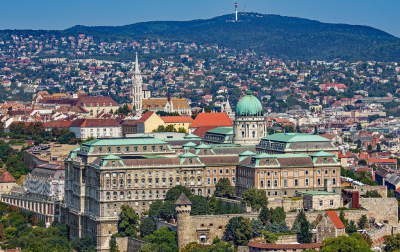
Budapest, Hungary's capital, is a UNESCO World Heritage Site because of its rich architectural legacy.
Ranu Joardar
Hungary, one of the several landlocked countries in Europe, is unique in itself. Having a language that is not related to any European language, the country has felt isolated through much of its history. It has produced a number of scientists, mathematicians, economists, anthropologists, musicians, and artists.
History
Hungary is referred to as Magyarorszag or the land of Magyars' by its citizens. Some believe that the country came into existence after the Magyars, a Finno-Ugric people, occupied the middle basin of the Danube River in the late 9th Century. However, archaeologist Gyula Laslo has opined that the country's history dates back to 670 with the arrival of the Late Avars, who were the early Magyars. The Magyars had a thriving society till 1241 when the Mongols invaded the region. The Mongols were defeated by the Magyars twice. It later became a part of the Ottoman Empire and remained so for several years. From 1699 till the First World War, Hungary was part of Austria. During the Second World War, Hungary fought alongside the Axis powers – Germany, Italy and Japan.
Geography
Hungary is bordered by Slovakia and Austria to the north, Ukraine and Romania to the east, Slovenia to the west, and Croatia and Serbia to the south.
The country is mostly flat and has a large lowland area known as the Great Hungarian Plain. The Danube River, the largest river in the country, cuts through the middle of the country. It crosses 10 countries on its way to the Black Sea. There are three key freshwater lakes including Lake Balaton, the largest in central Europe. Lake Balaton was designated as a World Heritage Site by UNESCO in 1989. Lake Heviz, which flows alongside the northern slope of Mount Keszthely, is one of the world's largest thermal lakes. Near the Slovakia border is the Aggtelek National Park, which was designated as a UNESCO World Heritage Site in the late 20th Century. Of eight World Heritage sites, the caves of Aggtelek Karst and Slovak Karst, is a natural site.
Flora and fauna
While half of the land is used for farming, about one-sixth is used for non-agricultural purposes and the remainder comprises meadows, rough pasture, forests and woodland. The Great Hungarian Plain is the grasslands covering the central and eastern part of the country. In the north of the plains is a mountain range known as the Northern Hills. The hilly areas in the west of the Danube River are known as the Transdanube.
The Great Hungarian Plain is home to several species of animals such as roe deer, wild boars, red foxes, mouflon sheep, and birds such as the imperial eagle and great bustard. In 1999, the United Nations designated Hortobagy National Park, the largest of Hungary's 10 national parks, as a UNESCO World Heritage Site. Many threatened and endangered species of fish such as sturgeon and the Danube salmon are found in the Danube River.
People
Since the 10th Century, Hungary has been a multi-ethnic country with the Magyars as the dominant population. The Hungarian language, Magyar, is part of the Finno-Ugric group of the Uralic language. It is written in Latin alphabet, but has 44 letters in total.
Music is integral to the Hungarian culture. Their folk music is based on the daily experiences of peasants in the countryside with themes ranging from joy and sadness to weather and farming. The two greatest composers – Bela Bartok and Franz Liszt – were from Hungary. It is the birthplace of many famous people such as Erno Rubik, inventor of the Rubik's Cube.
Red meat forms an important part of their cuisine such as Gulyas (a thick beef soup cooked with onions and potatoes) and Hungarian sausage. Paprika is common in most Hungarian dishes. The Hungarian national anthem is based on the poem 'Hymnusz' written by Hungarian Romantic poet Ferenc Kolcsey in 1823. It was officially adopted in 1844.
The Hungarian capital Budapest has a rich architectural legacy from various periods that led to it being designated as a UNESCO World Heritage Site. The Danube Banks and the Buda Castle District (having medieval and characteristically Baroque style) were the first sites in Budapest to have been included on the UNESCO World Heritage List in 1987. Budapest has the remains of monuments such as the Roman city of Aquincum and the Gothic castle of Buda, which influenced the architecture of various periods.
Government
Hungary is one of the new democracies. Throughout the 19th and 20th Centuries, the country's political system had elements of autocracy. While between 1867 and 1948, the country had a parliament with a multiparty system, in 1948 the communists took over and a Soviet-style political system was followed. In 1990, the country held its first democratic elections. It became a part of the European Union in 2004. The country is now a parliamentary republic, led by a President is elected by the public. The Prime Minister is the head of the government. The current President Katalin Novak is the first female President of Hungary.
Picture Credit : Google




